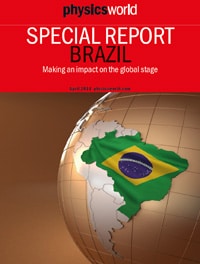By Matin Durrani

With this year’s FIFA World Cup drawing ever closer, Physics World turns its attention to Brazil – the nation hosting the planet’s biggest sporting event.
We’re not, of course, looking at the country’s footballing prowess or examining the controversial – and staggering – sums being spent on staging the World Cup.
Instead, the latest Physics World Special Report examines the challenges and opportunities for physicists in Brazil – the fifth biggest nation by size and the world’s seventh-largest economy.
Physics in the country is thriving, with the Brazilian government having more than quadrupled the amount of money invested in research and development since the turn of the century.
Our Special Report, which you can read free online, kicks off with an interview with Marco Antonino Raupp, the physicist who spent two years as Brazil’s science minister before being replaced in a government reshuffle on 17 March 2014 – just after we had gone to press. In the interview, Raupp underlines the importance of Brazil taking part “in the world science scene” and adds that the challenge for the country is to improve the quality of Brazilian researchers so as “to increase the impact of Brazil on world science”.
Elsewhere in the Special Report, which was based largely on visits to Brazil by myself and my colleague Susan Curtis, you can find out about construction of the Sirius X-ray synchrotron-radiation source, the opening of the first overseas offshoot of the International Centre for Theoretical Physics, and the impact of Brazil’s National Observatory – the country’s oldest scientific institution. There’s also an interview with Vanderlei Bagnato – head of the innovation agency at the University of São Paulo – and a look at Brazil’s attempts to improve the education and career prospects of Brazilian physicists.
Brazil was a fascinating place to visit and I’d like to thank the many people who hosted visits to the labs and facilities mentioned in the report.
For the record, here is a full list of contents.
• News – Catch up with Brazil’s attempts to join the CERN and the European Southern Observatory, and find out about its plans to build a giant underground lab beneath the Andes and its attempts to send more than 100,000 students abroad.
• Brazil takes centre stage – Our features pages begin with an overview of how the country’s recent investment is transforming Brazil’s physics research base.
• Meet the science minister – Marco Antonio Raupp, Brazil’s outgoing minister of science, technology and innovation, speaks out in an exclusive interview with Physics World.
• Sirius shines brightly for Brazil – Take a tour of the new Sirius facility being built in Campinas, which is not just another synchrotron radiation facility but seeks to be a world-leading laboratory.
• São Paulo realizes Salam’s dream – A profile of the first overseas offshoot of the celebrated International Centre for Theoretical Physics, founded by Nobel-prize-winning physicist Abdus Salam in Trieste, Italy, 50 years ago.
• Promoting innovation – Vanderlei Bagnato, head of the innovation agency at the University of São Paulo, explains why he thinks converting research into practical applications is so vital.
• Nurturing top talent in Brazil – Find out how improving school education, helping university students and boosting international research initiatives are vital to maintain Brazil’s research output.
• Long history, bright future – A look at the National Observatory in Rio de Janeiro – the place where Brazilian research pretty much begain way back in 1827.
This Special Report is published by Physics World – the member magazine of the Institute of Physics (IOP) – which appears 12 times a year. If you’d like to read Physics World each month, you can do so via the digital version of the magazine or via the Physics World app, available from the App Store and Google Play. If you’re not yet in the IOP, you can join as an IOPimember for just £15, €20 or $25 a year to get a full year’s access to Physics World both online and through the apps.



